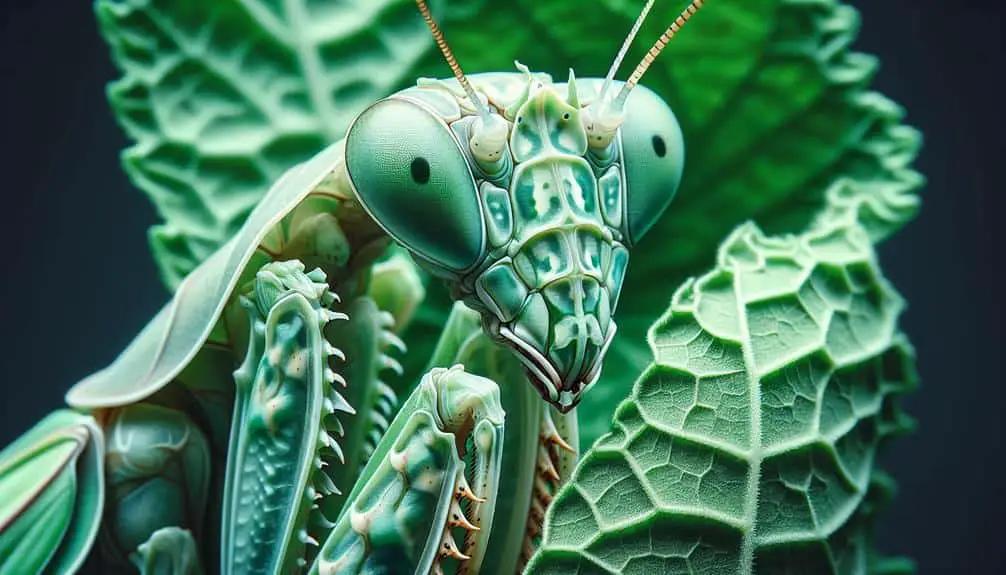Insects employ various breathing techniques for stealth missions. They include the lightning-fast flutter and silent wing whisper for quick and noiseless movements. Camouflaged antennae dance and stealthy silk sway aid in blending seamlessly. The shadowed beetle sigh, quiet cicada chant, and subtle moth breath guarantee quiet respiration for enhanced stealth. These strategies offer insects an advantage in evading detection in their environments. Each technique serves a specific purpose in the insects' survival and evolution. By exploring these insect breathing styles, you can uncover how these creatures master the art of stealth.
Key Points
- Stealthy respiration techniques like cryptic beetle breathing aid in undetected movement.
- Synchronized breathing patterns enhance insect stealth during missions.
- Silent moth breath helps insects avoid detection by predators.
- Rapid heartbeat facilitates swift wingbeats for quick evasive maneuvers.
- Camouflaged movements and breathing styles optimize oxygen intake while minimizing visibility.
Lightning-Fast Flutter
Employing a lightning-fast flutter, insects adapt their breathing styles to enhance stealth during missions, ensuring efficient oxygen intake while remaining undetected. This rapid heartbeat facilitates swift wingbeats, enabling insects to move with precision and speed, all the while keeping their hidden breath and presence veiled from potential predators. By synchronizing their movements with their breathing patterns, insects achieve a remarkable level of stealth, allowing them to navigate through their environments without alerting others to their whereabouts.
Insects have evolved sophisticated mechanisms to regulate their breathing during these stealth missions. Their ability to adjust the frequency and depth of their breaths in accordance with their rapid heartbeat and wingbeats is a testament to their remarkable physiological adaptations. This intricate coordination of physiological processes enables insects to optimize their oxygen intake while minimizing any detectable signs of their presence. Through this intricate interplay of biology and behavior, insects have mastered the art of silent movement, showcasing the elegance of their evolutionary adaptations in the domain of stealth missions.
Silent Wing Whisper
When flying on stealth missions, insects utilize silent wing whisper techniques to avoid detection. By minimizing turbulence and noise during flight, insects can move undetected through the air.
This vital flight capability plays a significant role in their camouflage and evasion strategies.
Noiseless Flight Techniques
Utilizing the intricate design of their wings, insects have perfected a stealth technique known as the Silent Wing Whisper for noiseless flight. This technique enables insects to move with silent glide and execute a stealthy approach, evading detection by predators or prey.
Insects employ noiseless hover, utilizing hidden tactics to maneuver through the air undetected. The significance of their wings plays a pivotal role in reducing sound production during flight, allowing for a seamless and silent movement through the environment.
Camouflage and Evasion
How do insects with the Silent Wing Whisper camouflage themselves and evade detection in their environment?
These insects have developed remarkable adaptation strategies to blend seamlessly into their natural habitats, allowing them to effectively evade predators. By utilizing their unique wing structure to produce minimal sound during flight, they can move undetected through the air, enhancing their survival techniques.
Additionally, their ability to mimic the colors and patterns of their surroundings further aids in predator avoidance, making them almost indistinguishable from their environment.
This combination of stealthy flight and effective camouflage showcases the sophisticated mechanisms these insects have evolved to thrive in their ecosystems, highlighting the intricate balance between adaptation and survival in the natural world.
Camouflaged Antennae Dance
Intriguingly, the camouflaged antennae dance of certain insects serves as an important tool for blending into their surroundings during stealth missions. Antenna camouflage plays a pivotal role in the silent movements of insects, allowing them to evade predators and stalk prey unnoticed. This intricate choreography involves subtle movements of the antennae, mimicking elements of the surrounding environment to avoid detection.
Insects adept at stealthy silk swaying employ shadowed beetle techniques to enhance their camouflage. By synchronizing the movements of their antennae with their surroundings, these insects create a visual illusion that conceals their presence from potential threats. This deceptive behavior showcases the evolutionary sophistication of insect communication and adaptation to their environment.
The camouflaged antennae dance showcases the remarkable ability of insects to utilize their physical attributes for survival in challenging environments. Through precise and calculated movements, insects can navigate their surroundings undetected, highlighting the intricate strategies employed in the world of insect stealth missions.
Stealthy Silk Sway
When an insect moves with stealthy silk sway, it employs a strategic combination of silent silk movements and camouflaged threads. This technique allows the insect to navigate its environment undetected, blending seamlessly into the surroundings.
Silent Silk Movements
Silent Silk Movements in insects are characterized by a remarkable ability to sway undetectably, enabling stealthy navigation through their environments. The intricate design of their silk stealth allows for silent movements, masking their presence from potential threats.
This stealthy maneuvering is achieved through a combination of specialized adaptations, including whispering wings that minimize sound production during flight. The vital nature of insect silk plays a pivotal role in these movements, providing a lightweight yet durable material for seamless gliding.
Camouflaged in Threads
Concealed within their intricate threads, insects adeptly blend into their surroundings through a stealthy silk sway, evading detection from potential threats with remarkable precision and efficiency. This threaded disguise isn't merely a simple cover but a demonstration of insect artistry and hidden movements. Here's why insects excel at camouflaging in threads:
- Silk Secrets: Insects utilize specialized silk glands to produce threads that match their environment perfectly.
- Meticulous Weaving: Through meticulous weaving techniques, insects create intricate patterns that mimic the surroundings.
- Adaptive Coloration: The silk threads can adapt in color and texture, providing a seamless blend with the background.
- Subtle Movements: Insects can subtly adjust their position and movements within the threads to avoid detection.
Shadowed Beetle Sigh
Amidst the complex world of insect respiration, the Shadowed Beetle's unique sigh serves as a fascinating adaptation worth exploring further. Unlike the mysterious glow emitted by some nocturnal insects to attract prey or mates, the Shadowed Beetle relies on its ability to blend into the darkness, utilizing its hidden retreat within the shadows as a form of insect camouflage. This beetle's respiration strategy is a marvel of evolution, allowing it to traverse its environment with stealth and precision.
The Shadowed Beetle's sigh is a soft, almost imperceptible sound produced as it breathes. This silent exhalation minimizes any disturbance in the air, making it virtually undetectable to potential predators or prey. Through this quiet respiration technique, the Shadowed Beetle enhances its chances of remaining hidden and undisturbed during its nocturnal activities.
In the domain of insect respiration, the Shadowed Beetle's sigh stands out as a remarkable example of adaptation for covert missions. By mastering the art of silent exhalation, this beetle excels in moving through the shadows undetected, showcasing the intricate and diverse strategies found in the world of insect breathing.
Quiet Cicada Chant
The subtle rhythm of the Quiet Cicada's chant during respiration presents a sophisticated adaptation worth exploring within the domain of insect breathing strategies. When it comes to mastering the art of stealth missions, the Quiet Cicada stands out for its unique breathing style. Here's why it's a valuable skill to learn:
- Hidden Insect Signals: The Quiet Cicada's chant serves as a covert signal to others of its kind, allowing for silent communication even in the midst of dense foliage.
- Whispering Wings: Its wings produce a soft rustling sound, aiding in cryptic movements that help it evade predators and move undetected through its environment.
- Stealthy Respiration: By regulating its respiration to create a barely audible chant, the Quiet Cicada minimizes the risk of detection, an essential advantage for any insect on a stealth mission.
- Adaptive Advantage: This breathing style showcases the evolutionary prowess of the Quiet Cicada, demonstrating how subtle adaptations can enhance survival in challenging environments.
Subtle Moth Breath
Among the intricate array of insect breathing styles, the Subtle Moth exhibits a remarkably discreet and efficient respiratory mechanism that merits detailed examination for its stealth capabilities. The delicate wing movements and secretive moth rituals contribute to its hushed fluttering and hidden maneuvers, making it a master of covert operations in the insect world.
The Subtle Moth's breathing strategy revolves around its intricate wing movements, which play a pivotal role in oxygen exchange. By subtly adjusting the positioning of its wings during flight, the moth optimizes airflow around its body, ensuring a constant supply of oxygen without creating any noticeable disturbance in the air. This unique adaptation allows the moth to remain undetected by predators or unsuspecting prey, enhancing its stealth capabilities during nocturnal activities.
Furthermore, the secretive moth rituals, such as specific grooming behaviors that regulate airflow over its body, add another layer of efficiency to its respiratory system. These hidden maneuvers help the Subtle Moth maintain a low profile while moving through its habitat, showcasing the evolutionary sophistication behind its unobtrusive breathing style.




